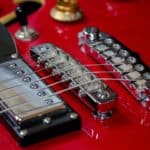You sit down, grab your guitar, turn on your amp and prepare to noodle around for an hour and consider it practice.
Then, you hear your high E string is slightly out of tune, and when you adjust it… SNAP! It breaks and your session is ruined.
If it is not the first time this happens to you, it’s reasonable you are looking for answers.
Seek no more.
High E guitar strings tend to break due to mechanical friction at the tuning pegs, the nut, fret edges, or bridge saddles. The most common fix for it is filing or sanding down those slots or edges, or even replacing those components for higher quality ones.
In this article, I will lay down the most common causes of strings breaking, and the best ways to prevent it.
After leaving this page you will have a clearer idea about how to make your precious strings last for longer.
Are you ready to get started?
Let’s go!
Why do guitar strings break?
Guitar strings break due to many different reasons. Some of the most common ones are rust and deterioration due to use or particular weather conditions, bridge, nut or tunning peg issues, playing too heavily, or rough fret edges.
Of course, your particular issue can be any of these or a combination of multiple ones. It takes some troubleshooting and single variable testing to figure it out.
In my experience, it’s not that common for strings to break, however, if you are a very heavy-handed player, and you play a lot, naturally, your risk of snapping a string would be increased.
What can cause the same string to break over and over?
If you are having trouble with a particular string on your guitar, you can probably discard any issues related to string wear or your playstyle. Because, although the first string is the most fragile, you should also be breaking any of the other ones from time to time.
The best place to start troubleshooting this issue is at the tuning peg, nut, bridge or even fret edges.
If you still have your broken string at hand, try to reconstruct it. Now, take a look at the breakage point, and try to define which part of your guitar it correlates.
Once you figure that out, you are set for starting to fix the issue.
We will discuss the most common fixes for this in a few sections below.
Is it common for the E string to snap?
The high E string is the most fragile one on a guitar. Of course, it has to do with it being the thinnest one.
If you bend a lot or have a strong vibrato, it will be the most likely string to snap, but that doesn’t mean that the other won’t ever break.
Strings become more fragile with time, and their snapping is inevitable, however, if you notice a consistent pattern on your breakages, the issue is probably with the guitar and not the string’s integrity.
How to fix the E string snapping?
As I mentioned earlier, there are at least 4 usual points where the E string commonly breaks.
From headstock to the bridge, they are the following:
- Overwinding strings or fitting them incorrectly
- Tuning pegs
- Nut
- Fret edges
- Bridge saddles
We will now discuss how to fix the most likely issues at each of these points:
Overwinding strings or incorrect fit
Learning how to wind your string properly on the tuning pegs is important. Here’s a great tutorial on how to do so:
Tuning pegs
The main culprit of string breakage at the machine heads is rough edges where strings touch the metal.
This could be easily fixed by filing away that roughness. A common way to do so is by rubbing a string against it. Wound strings (the thickest ones) work best for this, but any other small file will suffice.
If the issue persists, it would be wise to consider getting a new set of tuners. It could be an opportunity to go for higher-quality ones if your budget allows it.
Nut
Again, any deformation or strange object at the nut can be the cause of your string snapping.
A common fix for this is very similar to the last one. Sanding down the string slot and cleaning it will be more than enough in most cases.
Also, always remember to lubricate your nut properly every time you change strings.
In addition, coated strings are known to slide easily through the nut, reducing friction and chances of breaking.
Finally, replacing your nut with a higher quality one is always advisable, especially if the one on your guitar is not very good.
Fret edges
Sharp fret edges can wear your strings down at certain points weakening them and making them snap frequently at those places.
Again, the common solution is using a bit of sandpaper to smooth them out. There are even tools specific for this kind of work on frets.
Remember to cover your pickups thoroughly when doing this kind of work, since metal shavings can be attracted by their magnets, causing long-term issues that are very hard to solve.
Refretting or getting a professional fret dress is also an alternative for solving this issue.
Bridge saddles
The saddles at the bridge are the part of it that makes contact with the strings. They have small grooves to fit them, that can get a bit rough if not finished properly.
A little bit of sanding or filing will probably work to smooth them out. Again, remember to cover your pickups to prevent any shavings from being trapped inside.
Coated strings will also slide more easily at this point, and are recommended.
Finally, getting new saddles, or even a complete higher-quality bridge is also a nice upgrade if the one on your guitar is not of top-notch quality.
How to prevent the E string from snapping in the future?
Preventing strings to snap is impossible since it’s a normal thing that happens even on the higher quality guitars out there.
However, strings break consistently at some point, and any of the fixes mentioned above will work towards stopping it.
Now, to avoid normal use breakages, there are some best practices that you could start incorporating.
First of all, do your best to delay natural string decay. You can make sure to clean them after you finish playing and store your guitar in a place that’s not extremely humid.
Also, if string snapping is a common issue for you, you should consider moving to a thicker string gauge. More massive strings are tougher.
You could also work on your playing and try to be a bit less aggressive with it, but hey, if that’s your style, there’s nothing you can do about it!

Hello there, my name is Ramiro and I’ve been playing guitar for almost 20 years. I’m obsessed with everything gear-related and I thought it might be worth sharing it. From guitars, pedals, amps, and synths to studio gear and production tips, I hope you find what I post here useful, and I’ll try my best to keep it entertaining also.





